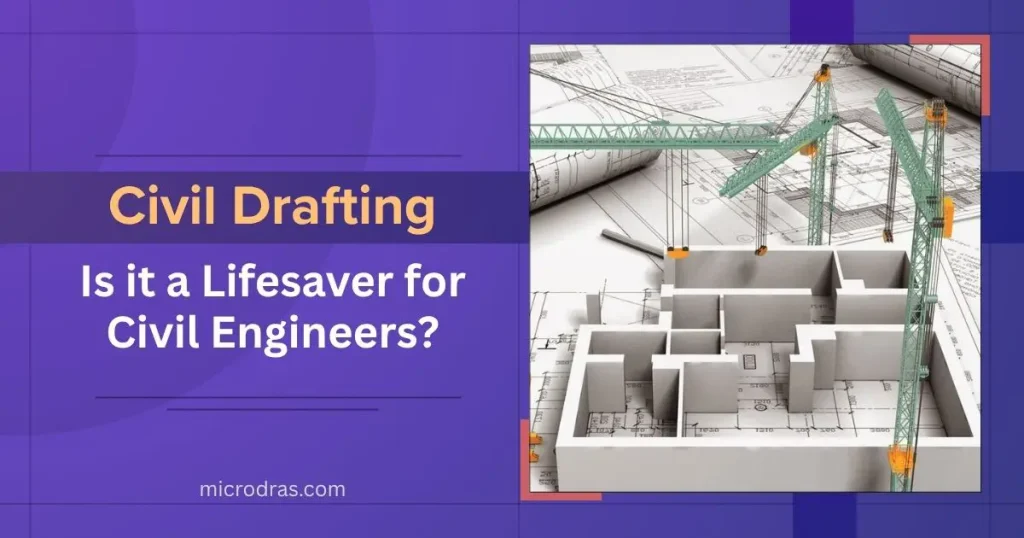In the construction industry, even a small design flaw can lead to major financial consequences. From misaligned structures to failed inspections, minor errors in planning can delay timelines, increase budgets, and jeopardize safety. That’s where civil drafting plays a vital role—it offers the precision and foresight necessary to avoid costly mistakes before they happen.
Why civil drafting is important?
Civil drafting is the process of creating accurate, scaled technical drawings for civil engineering projects such as roads, subdivisions, grading layouts, utility systems, and drainage plans.
These drawings guide construction teams through every stage of a project, ensuring that all dimensions, alignments, elevations, and connections are clearly defined and executed correctly.
With the adoption of Computer-Aided Design (CAD) tools, modern civil drafting ensures clean, editable, and standards-compliant blueprints that form the foundation for seamless execution and regulatory approvals.

Key ways civil drafting prevents costly construction errors
1. How does civil drafting identify conflicts early?
One of the biggest advantages of civil drafting is the early detection of design conflicts—before any construction begins or materials are ordered.
Examples of preventable issues include:
- Grading inconsistencies that can lead to water runoff problems or foundation instability
- Utility clashes, such as water pipes intersecting electrical ducts
- Incorrect slope calculations causing poor drainage or surface pooling
With precise civil drafts, these issues can be resolved during the design phase, where changes are easier and more affordable.
2. How does civil drafting reduce rework and delays?
Construction rework is a common budget-drainer, causing delays, increased labor costs, and wasted materials. Civil drafting reduces rework by offering accurate:
- Cut & fill diagrams for efficient earthworks
- Grading plans that align with actual terrain profiles
- Utility layouts that minimize conflicts and unnecessary trenching
When teams follow detailed plans, they minimize improvisation and complete tasks with greater confidence and speed.
3. Does civil drafting help with regulatory approvals?
Yes. Obtaining construction permits requires thorough documentation that aligns with zoning regulations, safety standards, and environmental guidelines. Poorly drafted plans can result in:
- Permit denials
- Compliance penalties
- Legal disputes with local authorities or property owners
Professionally prepared civil drafts include all necessary engineering data, symbology, and annotations to expedite approvals and reduce legal risks.
4. Can civil drafting improve cost estimations?
Accurate budgeting starts with accurate planning. Civil drafting provides reliable data that supports:
- Earthwork volume calculations
- Material takeoffs
- Labor scheduling
With clear visuals and measurable quantities, project managers can build realistic budgets and avoid financial surprises.
Studies show up to 32% of cost overruns stem from estimation errors, especially when based on incomplete or ambiguous design documents.

5. How does civil drafting improve cross-team communication?
Successful construction depends on seamless communication between architects, civil engineers, contractors, and clients. Ambiguous or inconsistent plans often lead to misunderstandings and execution errors.
High-quality civil drafting serves as a single source of truth, enabling:
- Better coordination between departments
- Fewer on-site changes or corrections
- Clearer expectations across all phases of the project
Real Feedback from Construction Pros
Professionals have seen firsthand what happens without accurate drafting:
“I constantly review IFC sets and still see big design changes after bidding—leading to costly change orders and schedule delays.”
“Inaccurate quantities—like rebar or concrete—can balloon costs by 5–10% or more. QA/QC and proper drafting would have flagged those.”
The ROI of Investing in Professional Civil Drafting
| Benefit | Impact |
|---|---|
| Reduced rework | Save 5–12% in project value & schedule |
| Better cost control | Mitigate up to ~10% budget overruns |
| Faster approvals | Less permit delays and legal exposure |
| Clear documentation | Enhances cross-team coordination |
| Proven expertise | Minimize mistakes, build trust |
Your Expert in Construction-Ready Drafting
Microdras delivers precise, code-compliant civil drafting with expert CAD specialists and engineers, ensuring accurate, approval-ready drawings that save time, money, and costly construction errors.
Why investing in civil drafting pays off?
Construction errors are expensive—but entirely avoidable. By investing in professional civil drafting, you gain:
- Precision in dimensions and layouts
- Early detection of potential issues
- Faster regulatory approvals
- Reliable cost estimations
- Improved team collaboration
Protect your project’s budget, timeline, and integrity. Choose Microdras to get the insight and accuracy you need to build smarter, safer, and more efficiently.

